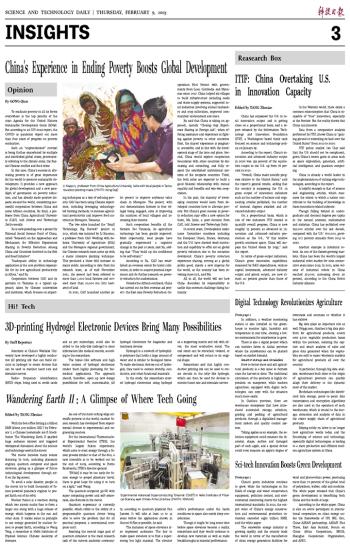
 China's Experience in Ending Poverty Boosts Global Development
China's Experience in Ending Poverty Boosts Global Development ITIF: China Overtaking U.S. in Innovation Capacity
ITIF: China Overtaking U.S. in Innovation Capacity Digital Technology Revolutionizes Agriculture
Digital Technology Revolutionizes Agriculture 3D-printing Hydrogel Electronic Devices Bring Many Possibilities
3D-printing Hydrogel Electronic Devices Bring Many Possibilities Wandering Earth II:A Glimpse of Where Tech Going
Wandering Earth II:A Glimpse of Where Tech Going Sci-tech Innovation Boosts Green Development
Sci-tech Innovation Boosts Green Development
China has surpassed the U.S. in total innovation output and is getting close on a proportional basis, said a report released by the Information Technology and Innovation Foundation (ITIF), a Washington-based think tank focused on science and technology policy, on January 23.
According to the report, China's innovation and advanced-industry output in 2020 was 139 percent of the equivalent output in the U.S. up from 78 percent in 2010.
"Overall, China made notable progress relative to the United States," said the report's general results, adding that the country is surpassing the U.S. in gross output of innovation indicators such as the number of science and engineering articles published, the number of doctoral degrees awarded and advanced-industry output.
On a proportional basis, which is one of two indicators ITIF created to quantify overall progress, China is now roughly 75 percent as advanced in innovation and advanced-industry production as the U.S., "If this relative growth continues apace, China will surpass the United States by 2035," said the report.
In terms of gross-output indicators, China's gross innovation capabilities, measured by R&D expenditures, venture capital investments, advanced-industry output and patent output, are now almost 40 percent greater than those of the U.S.
In the Western world, there exists a common misconception that China is incapable of "true" innovation, especially at the frontier. But the reality shows that China can innovate.
Data from a comparative analysis performed by ITIF, shows China is "gaining ground or extending its lead over the United States" from 2010 to 2020.
ITIF policy analyst Ian Clay said that the U.S. should not be complacent, given China's recent gains in areas such as space exploration, genomics, artificial intelligence, and quantum computing.
China is already a world leader in the implementation of cutting-edge technologies, according to the report.
A helpful example is that of science and engineering articles, which measures the extent to which a nation contributes to the building of knowledge in these innovation-related subjects.
Though falling behind in undergraduate and doctoral degrees per capita in the natural sciences, mathematics and statistics, China has published over 742,000 articles over the last decade, compared with the U.S.' 600,000, growing 10.7 percent annually from 2015 to 2020.
Another example is industrial robots. As one of the fastest-growing markets, China has been the world's largest industrial robot market for nine consecutive years since 2013. In 2021, sales volume of industrial robots in China reached 271,000, increasing about 50 percent, according to the China Robot Industry Alliance.


 Next
Next



